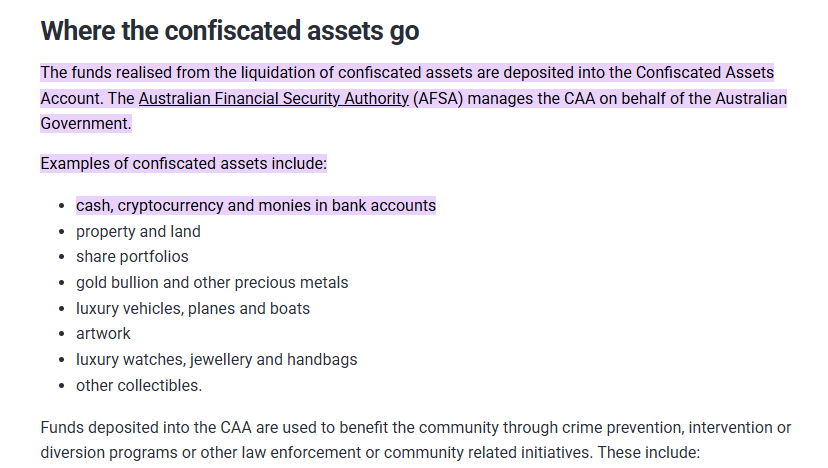Australian authorities have seized $6 million (AU$9 million) worth of cryptocurrency after a data scientist from the Australian Federal Police (AFP) uncovered a manipulated recovery phrase that had long concealed the digital fortune of an alleged criminal.
The revelation came from AFP Commissioner Krissy Barrett, who detailed the operation during her address at the National Press Club on Wednesday.
Barrett described how a near-missed opportunity turned into a landmark seizure thanks to one analyst’s persistence and technical intuition.
“It was a moment of scientific epiphany,” Barrett said. “One of our data scientists realized that the alleged offender had intentionally altered the seed phrase by adding extra numbers to mislead investigators. Once he removed those, the wallet opened, revealing millions in crypto.”
How a Hunch led to a Multimillion-Dollar Seizure
The case began when AFP’s Criminal Assets Confiscation Taskforce (CACT) discovered a suspected offender believed to have accumulated illicit crypto profits through selling tech products to international criminal networks.
During a search of the suspect’s home, investigators found password-protected notes on his mobile device. One image contained groups of numbers and words that initially puzzled forensic analysts.
Digital investigators suspected it might correspond to a crypto wallet but were unable to unlock it without the recovery phrase, a sequence of 24 words required to access the funds.
The alleged offender refused to provide his passwords, a violation of Commonwealth law that carries up to 10 years in prison.
That refusal set the stage for what would become one of the AFP’s most impressive technical recoveries.
The breakthrough came when one of CACT’s data scientists noticed inconsistencies in the number strings. They didn’t appear computer-generated. Instead, they looked manually modified, a possible trick to mislead authorities.
Acting on instinct, he removed the first digit from each group and successfully decoded the wallet’s 24-word seed phrase, unlocking a hidden balance worth AU$9 million.
“He said the numbers didn’t feel right,” Barrett recalled. “They looked human — not machine. And he was right.”
The same analyst later repeated the feat in a separate case, recovering another $3 million in digital assets using a different technique.
The Legal Process and What Happens Next
The recovered funds have since been restrained by the AFP-led CACT.
Once the courts approve confiscation, the money will be deposited into the Commonwealth Confiscated Assets Account (CAA), a government pool used to fund law enforcement, crime prevention, and community safety programs.
Under Australian law, confiscated criminal proceeds are not returned to victims but are instead reallocated to law enforcement, crime prevention, and community safety initiatives.

The funds are managed by the Australian Financial Security Authority (AFSA) and distributed through the Attorney-General’s Department under the Proceeds of Crime Act 2002 (POCA).
That means the seized $6 million will eventually help fund operations that target organized crime, drug trafficking, and cybercrime, effectively turning illicit gains into tools for public safety.
Australia’s Broader Push Against Crypto Crime
The seizure adds to a growing list of successful digital asset crackdowns by Australian law enforcement in 2024 and 2025.
In June, the Queensland Joint Organised Crime Taskforce charged four people in a $123 million money laundering scheme that converted illicit cash into cryptocurrency. That operation led to the restraint of more than AU$21 million in assets, including luxury properties and vehicles.
In May, the AFP confiscated a $4.5 million waterfront mansion, a Mercedes-Benz, and nearly 25 Bitcoin from a Queensland man connected to a U.S. cybercrime case.
And in October 2024, Victoria Police reported its first digital asset seizures under newly amended confiscation laws, which granted officers expanded powers to access crypto during investigations.
Australian police have conducted a number of seizures under Operation Kraken, a sweeping investigation into organized crime.
Last October, the AFP announced that it had seized $6.1 million (AU$9.3 million) following the arrest of Jay Je Yoon Jung, who is accused of creating and maintaining Ghost, an encrypted messaging platform used by organized crime syndicates worldwide.
These actions reflect Australia’s broader effort to modernize its anti-money laundering (AML) and counter-terrorism financing (CTF) frameworks amid a global rise in crypto-linked crimes.
The Rise of AFP’s “Crypto Safe Crackers”
Commissioner Barrett used the case to show the AFP’s evolving technical capabilities, particularly within its data science and digital forensics units.
The agency has been working with Microsoft to develop artificial intelligence tools capable of interpreting online slang, emojis, and encrypted communications to detect criminal activity.
She also announced Taskforce Pompilid, a new initiative dedicated to dismantling decentralized online crime networks operating across Australia and offshore.
For the AFP, the $6 million crypto seizure serves not just as a financial victory, but as proof of how human ingenuity can outthink even the most tech-savvy criminals.
“Our members are smart, determined, and innovative,” Barrett said. “This case reminds us that behind every algorithm and encryption is a human mind — and sometimes, it takes another human to beat it.”
The post Australian Police Seize $6M in Crypto After Analyst Exposes Manipulated Seed Phrase appeared first on Cryptonews.


 Australian authorities have confiscated a luxury waterfront mansion, a Mercedes-Benz, and nearly 25 Bitcoin from a Queensland man.
Australian authorities have confiscated a luxury waterfront mansion, a Mercedes-Benz, and nearly 25 Bitcoin from a Queensland man. Australian
Australian 